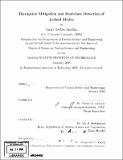Disruption mitigation and real-time detection of locked modes
Author(s)
Angelini, Sarah Martha
DownloadFull printable version (7.421Mb)
Other Contributors
Massachusetts Institute of Technology. Dept. of Nuclear Science and Engineering.
Advisor
Robert S. Granetz.
Terms of use
Metadata
Show full item recordAbstract
Disruptions are one of the largest problems facing tokamaks. In a large-scale experiment such as ITER, disruptions may cause crippling damage and severe setbacks in experimentation. One method for disruption mitigation involves the use of a gas jet which has been tested on both stable plasmas and vertical displacement events (VDEs) on Alcator C-Mod. In both cases, the jet was successful in mitigating disruption effects. The gas jet has not yet been tested on other types of disruptions. Locked-mode disruptions are easily created in C-Mod and could be used to test the effectiveness of the gas jet as a mitigation method if the jet could be fired early enough. It has been empirically observed that the electron cyclotron emissions (ECE) signal displays a flattening of the normally-present sawteeth before the current quench occurs in certain locked-mode disruptions. A procedure has been written which detects the ECE sawtooth suppression by calculating changes in the standard deviation of the signal over a moving time-window. This procedure has been programmed into the digital plasma control system (DPCS) for real-time testing. The procedure successfully located the locked modes present during a run.
Description
Thesis (S.M.)--Massachusetts Institute of Technology, Dept. of Nuclear Science and Engineering, 2008. Includes bibliographical references (p. 41).
Date issued
2008Department
Massachusetts Institute of Technology. Department of Nuclear Science and EngineeringPublisher
Massachusetts Institute of Technology
Keywords
Nuclear Science and Engineering.
